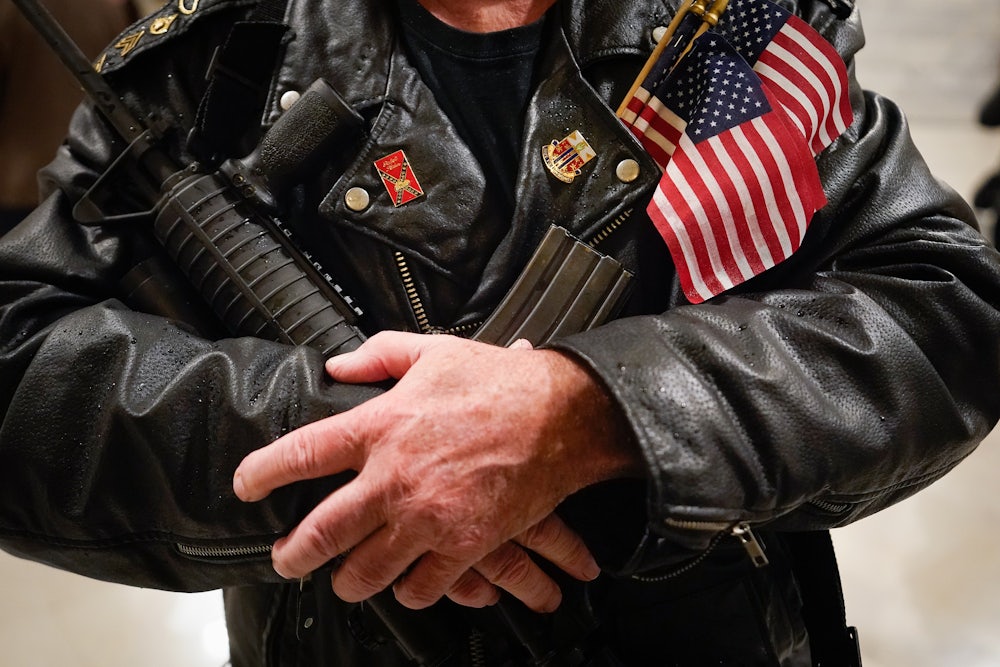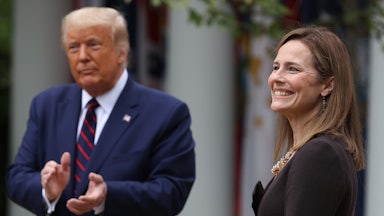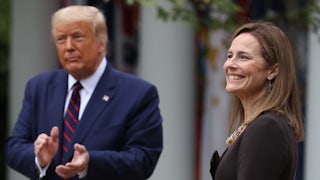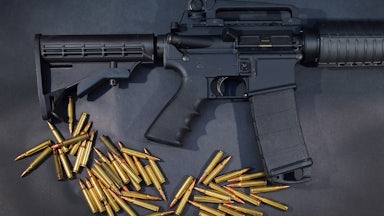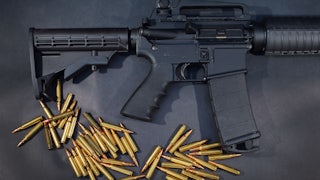On Monday, the Supreme Court announced that it would hear a case challenging New York’s concealed-carry laws, setting up what could be the court’s first major Second Amendment ruling in a decade. Gun-rights activists and some conservative justices have decried the court for treating the Second Amendment as a “second-class right” in recent years. The new case will likely give the court’s conservatives the opportunity to change course.
Just how far they’ll go remains to be seen, however. It’s surprising that the high court has gone this long without taking up the matter of gun rights. For many other Americans, it’s been an inescapable political conversation at the same time. The court’s silence also means that whatever the justices decide could have a profound influence on future gun-rights cases, as well.
The case, New York State Rifle & Pistol Association v. Corlett, takes aim at New York’s system for obtaining a concealed-carry license. State law only allows most applicants to get one if they show “proper cause” for obtaining one. In practice, state licensing officials are not required to provide licenses to carry guns outside a home or business in most circumstances. The two plaintiffs, Robert Nash and Brendan Koch, cited fears about crime in their communities in their applications. Licensing officers declined to issue permits to either man.
Nash and Koch, joined by a state gun-rights group, then sued New York for violating the Second Amendment. Both a federal district court and the Second Circuit Court of Appeals rejected their lawsuit. In 2008, the Supreme Court ruled in D.C. v. Heller that the Second Amendment protects an individual right to bear arms. Since the Heller case involved a Washington, D.C., law that limited gun ownership at home, the Second Circuit ruled four years later that the Supreme Court’s ruling in Heller didn’t apply to carrying a gun in public. In 2018, the appeals court ruled that its previous decision narrowing Heller also applied in Nash and Koch’s case and upheld a motion to dismiss their lawsuit.
The plaintiffs asked the Supreme Court to intervene last December. In their briefs, they argued that the Second Circuit had misread Heller too narrowly and gave too much deference to state officials to determine when a constitutional right could be used. “In sum, this Court’s opinions interpreting the meaning of the right to keep and bear arms are unequivocal: The Second Amendment, at its core, guarantees a fundamental, individual right to self-defense,” they wrote. “Any construction of the Second Amendment that denies a right to carry a firearm outside the home is inconsistent with common sense and this Court’s jurisprudence.”
In a brief opposing the plaintiffs’ petition, the state of New York criticized what it described as an “extreme position” from the plaintiffs. “They argue that the Constitution commands every State and locality to give individuals unfettered freedom to carry concealable firearms in virtually any public place,” the state noted. It also disputed the plaintiffs’ “grossly reductive” portrayal of historical laws and precedents on the matter. “A more nuanced understanding of the historical record establishes that New York’s licensing scheme fits comfortably within a 700-year-old Anglo-American tradition of regulating the carrying of dangerous weapons in the public sphere,” the state added.
New York’s interpretation of history was echoed recently by Judge Jay Bybee, a George W. Bush appointee to the Ninth Circuit Court of Appeals, in the case Young v. Hawaii. At issue in that case was Hawaii’s long-standing process for obtaining a concealed-carry license. The state generally required most citizens to show “an exceptional case” for needing a license to a county police chief, among other requirements. In a 127-page review of the legal history at hand, Bybee concluded that Hawaii’s system did not violate the Second Amendment.
“Our review of more than 700 years of English and American legal history reveals a strong theme: [The] government has the power to regulate arms in the public square,” he wrote. “History is messy and, as we anticipated, the record is not uniform, but the overwhelming evidence from the states’ constitutions and statutes, the cases, and the commentaries confirms that we have never assumed that individuals have an unfettered right to carry weapons in public spaces. Indeed, we can find no general right to carry arms into the public square for self-defense.”
It’s unclear whether the Supreme Court’s conservative supermajority will adopt this interpretation of the Second Amendment. Some of them clearly do not. After the court refused to hear a challenge to California’s concealed-carry regime in 2017, Justice Clarence Thomas claimed that his colleagues were treating the Second Amendment as a “disfavored right” compared to the First and Fourth Amendments. “For those of us who work in marbled halls, guarded constantly by a vigilant and dedicated police force, the guarantees of the Second Amendment might seem antiquated and superfluous,” Thomas wrote in a dissent joined by Justice Neil Gorsuch. “But the Framers made a clear choice: They reserved to all Americans the right to bear arms for self-defense.”
Thomas’s frustration reflected a growing discontent among gun-rights advocates with the court’s silence on the matter. Those advocates achieved two major victories with Heller in 2008 and then with McDonald v. Chicago in 2010, which applied Heller’s ruling to the states. In the decade that followed those landmark rulings, however, the court declined to hear challenges to a variety of gun restrictions. The justices brushed aside challenges to concealed-carry laws, assault-weapon bans, trigger-lock requirements, age restrictions for purchases, and more.
As a result, the legal landscape after Heller and McDonald largely resembled the one that came before it. The first sign of movement from the justices came last term, when they agreed to hear a challenge to an unusual New York City ordinance on handgun ownership. But the city, fearing defeat in the courts, moved instead to repeal the policy in question. The justices accordingly ruled last April that the case had become moot. Justices Thomas, Gorsuch, and Samuel Alito wrote that they would have struck down the ordinance anyway, while Justice Brett Kavanaugh signaled that he would be interested in hearing more Second Amendment cases in the future.
The court does not reveal how each justice votes on individual petitions before the court. Since any four justices can compel the court to hear a case, most observers assumed that Chief Justice John Roberts or Anthony Kennedy before his retirement were responsible for the court’s decade of inaction. Either way, Justice Amy Coney Barrett’s confirmation last fall likely changed the calculus in the conservative bloc’s favor. Barrett indicated while serving on the Seventh Circuit that she held an expansive view of the Second Amendment’s protections. She suggested in one dissent, for instance, that state and federal laws banning gun ownership by felons may be overbroad and thus unconstitutional.
If the Supreme Court is willing to interpret the Second Amendment more broadly for the foreseeable future, it could severely undermine efforts by gun-control activists to pass new restrictions at the state and federal levels. But all hope is not yet lost for them. The court already signaled on Monday that it would be unwilling to go as far as gun-rights groups want it to go. In their petition, the plaintiffs asked the court to consider “whether the Second Amendment allows the government to prohibit ordinary law-abiding citizens from carrying handguns outside the home for self-defense,” setting the stage for a sweeping ruling on concealed-carry restrictions across the country.
But in their list of orders on Monday, the justices applied some caveats when agreeing to hear the case. The court said it would instead consider “whether the state’s denial of petitioners’ applications for concealed-carry licenses for self-defense violated the Second Amendment.” Gun-control optimists and gun-rights pessimists might conclude that the justices still aren’t willing to hand down decisive rulings on the Second Amendment’s scope. Gun-control pessimists and gun-rights optimists might simply infer that the court is taking it one step at a time instead. Both sides will learn more when the court schedules oral arguments later this fall.
